3. Building a Sustainable and Resilient International Community through Efforts to Address Global Challenges
As globalization advances, transboundary challenges facing humanity include environmental issues and climate change, water-related issues, major natural disasters, infectious diseases, food issues, and energy issues. These challenges significantly affect not only developing countries but also the international community as a whole. These global challenges cannot be dealt with by a single country, and require united efforts by the international community. Against this backdrop, 2015 was an especially important milestone year for the international community’s response to global challenges. Major international conferences were held, including the UN Summit (September, New York), which adopted the 2030 Agenda for Sustainable Development that succeeds the MDGs, and COP 21 (November-December, Paris), which adopted the Paris Agreement, a new international framework on climate change for 2020 and beyond.
Japan contributes to building a sustainable and resilient international community through these proactive efforts to address global challenges.
(1) Environment and Climate Change Actions
The environment emerged as a major topic of discussion in international fora in the 1970s. The importance of addressing environmental challenges has been increasingly recognized through discussions at the United Nations Conference on Environment and Development (UNCED, also known as the Earth Summit) in 1992, the World Summit on Sustainable Development (WSSD) in 2002, and the United Nations Conference on the Sustainable Development (Rio+20) in June 2012. Rio+20 was followed by a series of discussions on Sustainable Development Goals (SDGs).* Additionally, environment and climate change issues have been repeatedly taken up as one of the main themes at the G7/8 and the G20 Summits, where the leaders conduct candid and constructive discussions on these topics. Environmental issues are challenges that the entire international community must address in order to ensure the prosperity of humankind in the future. In order to address global issues and build a sustainable society, UNESCO plays a central role in promoting Education for Sustainable Development (ESD).*
< Japan’s Efforts >
| Environmental Pollution Control
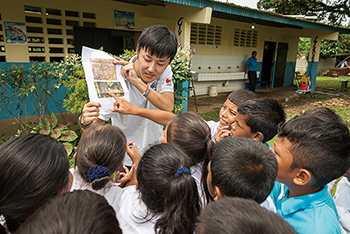
A Japan Overseas Cooperation Volunteer, Mr. Ryo Tamaoki visits elementary schools in the area of the Chagres National Park, which is located in the Panama Canal Watershed, Panama, and conducts educational activities for pupils in order to convey the importance of environment conservation. (Photo: Maximo Novas)
Japan has accumulated an abundance of knowledge, experience and technology related to environmental pollution control, and has been utilizing them to resolve pollution issues as well as other issues that developing countries face. In particular, Japan implements initiatives to provide support for pollution control measures and for improving the living environment in urban areas, mainly in Asian countries, which are undergoing rapid economic growth. On October 9 to 11, 2013, the Diplomatic Conference for the adoption and signing of the Minamata Convention on Mercury was held in Kumamoto City and Minamata City, Kumamoto Prefecture. This convention sets out comprehensive regulations on the whole life cycle of mercury, from mining to disposal, in order to reduce the risks of mercury on human health and the environment.
Having learned hard lessons from the experience of Minamata Disease, and being firmly determined that similar health hazards and environmental pollution should never be repeated, Japan proactively participated in the negotiations on the convention and took on the role of host country for the Diplomatic Conference. At the conference, Japan pledged $2 billion of ODA over three years to support developing countries to address the issues of air pollution, water contamination, and waste management, and also announced the launch of the MOYAI Initiative to disseminate information on mercury technologies and environmental restoration from Minamata to the rest of the world.
In addition, to support activities in developing countries to reduce substances that deplete the ozone layer, Japan makes contributions to the Multilateral Fund for the Implementation of the Montreal Protocol on Substances that Deplete the Ozone Layer.
| Climate Change
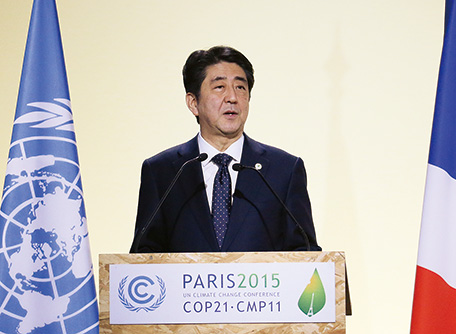
Prime Minister Shinzo Abe delivers a speech at the COP21 Summit Meeting held in Paris, France, in November, 2015. (Photo: Cabinet Public Relations Office)
Climate change is an urgent issue that requires a cross-border approach. According to the Synthesis Report of the latest Fifth Assessment Report(Note 24) published by the Intergovernmental Panel on Climate Change (IPCC) in November 2014, the global average air temperature increased by 0.85°C from 1880 to 2012. Against this backdrop, the international community, including both developed and developing countries, must strengthen its united efforts to address climate change. Japan actively engages in the negotiations on international efforts to tackle climate change, which are conducted in accordance with the UN Framework Convention on Climate Change.
At COP 19 in 2013, to support the mitigation and adaptation measures(Note 25) of developing countries, Japan pledged to provide ¥1.6 trillion (equivalent to approximately $16 billion) during the three-year period from 2013 to 2015, making use of official and private flows. This pledge was achieved in just over one and a half years from 2013.
At COP 20 held in Lima, Peru in December 2014, Parties decided on the information that might be contained in the Intended Nationally Determined Contributions (INDC),* which Parties were invited to communicate well in advance of COP 21. Accordingly, in July 2015, Japan decided on and communicated its INDC to the secretariat of the UN Framework Convention on Climate Change. Japan’s INDC will reduce greenhouse gas (GHG) emissions by 26% by FY2030 compared to the FY2013 level (25.4% reduction compared to the FY2005 level).
COP 21 (November 30-December 13, 2015, Paris), following on from COP 20, was a crucial international conference that established a new international framework for 2020 and beyond. To help reach this important agreement, Japan, in advance of COP 21, developed Actions for Cool Earth (ACE 2.0), a two-fold contribution composed of assistance to developing countries and innovation. Prime Minister Abe unveiled ACE 2.0 at the Leaders Event of COP 21 that he attended. Most notably, Prime Minister Abe announced that Japan would raise its annual public and private climate finance for developing countries to ¥1.3 trillion by 2020, 1.3 times the current level. The Prime Minister introduced that Japan would support Japanese companies’ projects that utilize renewable energies such as geothermal and solar energies, share the experiences of Japanese cities with emerging Asian cities, and establish early warning systems for natural disasters in Pacific island countries.
Due in part to Japan’s contributions, the Paris Agreement—an international framework that for the first time involves all countries—was adopted. Japan appreciates that agreement was reached on establishing a fair and effective legal framework that applies to all countries, as has long been advocated by Japan.
In other efforts to actively contribute to solving urgent challenges, Japan works steadily towards the achievement of its INDC, and proactively promotes the development of innovative technologies in the fields of environment and energy and supports climate change actions in developing countries.
As a part of this initiative, Japan has been promoting the Joint Crediting Mechanism (JCM)* through which leading low-carbon technologies have been globally utilized. JCM is a mechanism both to appropriately evaluate contributions from Japan to GHG emission reductions or removals in a quantitative manner achieved through the diffusion of low-carbon technologies and other systems as well as implementation of mitigation actions in developing countries, and to use them to achieve Japan’s emission reduction target. Beginning with the signing of the first bilateral document pertaining to JCM implementation with Mongolia in January 2013, Japan has established JCMs with 16 countries, i.e., Mongolia, Bangladesh, Ethiopia, Kenya, Maldives, Viet Nam, Laos, Indonesia, Costa Rica, Palau, Cambodia, Mexico, Saudi Arabia, Chile, Myanmar, and Thailand, as of December 2015 (in addition to these 16 countries, Japan and the Philippines have signed a memorandum to reach agreement on a bilateral document).
At the G20 Brisbane Summit in November 2014, Japan announced pledges to the Green Climate Fund (GCF)*, which supports developing countries in the field of climate change. Following the passage of the Act on Contributions to the Green Climate Fund and on Relevant Measures (Act No. 24 of 2015) on May 20, 2015, the Japanese government decided to contribute $1.5 billion (approximately ¥154 billion) to the GCF. Japan’s contribution brought the GCF over the threshold required to start providing finance to developing countries. Subsequently, at the 11th meeting of the GCF Board in November, eight projects, including projects in island countries, were approved for the GCF’s first set of projects.
In December 2015, the Fourth East Asia Low Carbon Growth Partnership Dialogue was held as a side event of COP 21 to discuss the direction of East Asia low carbon growth. Coinciding with this event, a proposal that takes into account the findings gained up to the third dialogue was presented. At the event, Viet Nam, Cambodia, Malaysia, and Japan introduced best practices of low carbon growth.
| Biodiversity
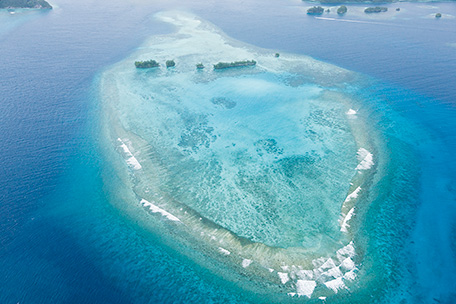
An atoll reef near the Mecherchar Island in the state of Koror, Palau. (Photo: Kaku Suzuki / JICA)
In recent years, the expanding scope, scale, and type of human activities have given rise to serious concerns over the degradation of the habitats of living organisms and the destruction of the ecosystem. Since the existence of living organisms is borderless, the entire world should tackle biodiversity issues; therefore, the Convention on Biological Diversity (CBD) was adopted. The objectives of the CBD are: (i) conservation of biological diversity; (ii) sustainable use of its components;* and (iii) fair and equitable sharing of the benefits arising out of the utilization of genetic resources. Developed countries are providing economic and technical assistance to developing countries in an effort to realize the conservation and sustainable use of biological diversity.
Japan, which places importance on biodiversity, hosted the 10th Meeting of the Conference of the Parties to the Convention on Biological Diversity (COP 10) in Nagoya City, Aichi Prefecture in October 2010. In October 2014, the 12th Meeting of the Conference of the Parties to the Convention on Biological Diversity (COP 12) was held in Pyeongchang, the Republic of Korea. A mid-term review of the Aichi Biodiversity Targets* adopted at COP 10 was conducted, and Japan proactively contributed to the discussions in order to maintain the momentum for achieving the Aichi Biodiversity Targets.
At COP 12, it was decided that by 2015, total biodiversity-related international financial resource flows to developing countries would be doubled from the average level of 2006-2010, and that this level would be maintained until 2020.
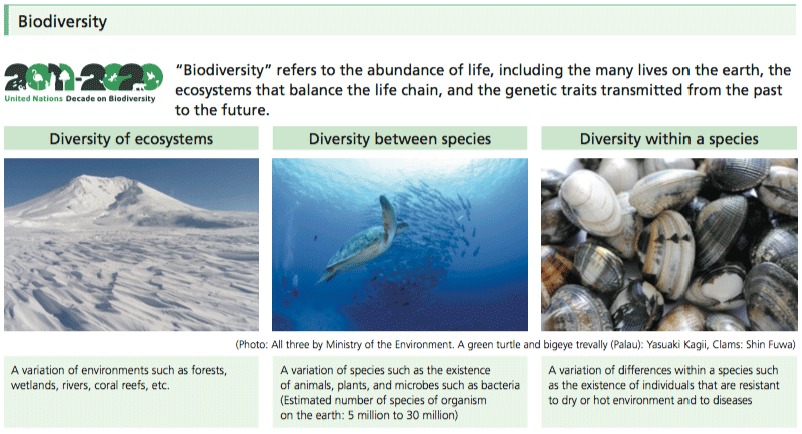
| Promotion of the Education for Sustainable Development (ESD)
Japan puts emphasis on realizing sustainable development through education. To mark the end of the UN Decade of Education for Sustainable Development (DESD), which was originally proposed by Japan, Japan and UNESCO co-organized the UNESCO World Conference on ESD in Okayama City and in Nagoya City, Aichi Prefecture in November 2014. Since 2005, the first year of DESD, Japan has actively promoted ESD through, inter alia, contributing Funds-In-Trust to UNESCO and implementing the ESD projects.
- *Sustainable Development Goals (SDGs)
- SDGs refer to development goals that were discussed at the UN Conference on Sustainable Development (Rio+20) held in Rio de Janeiro, Brazil in June 2012, at which an agreement was reached to launch an intergovernmental negotiation process. The SDGs apply to all countries based on the capacities of each country. The SDGs were integrated into the 2030 Agenda for Sustainable Development at the UN Summit in September 2015.
- *Education for Sustainable Development (ESD)
- ESD refers to education to foster leaders of a sustainable society. In this context, “sustainable development” means the development of a society that “meets the needs of the present generation without compromising the ability of the future generation to meet their own needs.” This requires each of us to be aware of this concept in our daily lives and economic activities, and to make changes in our individual behavior. Educational activities to achieve such purposes are considered “Education for Sustainable Development.”
- *Intended Nationally Determined Contribution (INDC)
- INDC refers to a target for tackling climate change that each country communicates well in advance of COP 21 for the purpose of establishing a new international framework for 2020 and beyond (Paris Agreement).
- *Joint Crediting Mechanism (JCM)
- JCM refers to a mechanism in order both to appropriately evaluate contributions from Japan to GHG emission reductions or removals in a quantitative manner achieved through the diffusion of low carbon technologies, products, systems, services, and infrastructure, as well as implementation of mitigation actions in developing countries, and to use them to achieve Japan’s emission reduction target.
- *Green Climate Fund (GCF)
- GCF refers to a fund whose establishment was decided by the Cancun Agreements adopted at COP 16 in 2010, in order to help developing countries reduce GHGs and adapt to climate change.
- *Sustainable Use of Biodiversity and Components
- Humans subsist by making use of biological resources in various forms, including food production by the agricultural, forestry, and fishery industries and the collection of industrial raw materials. However, biological diversity is being lost across the globe due to climate change, environmental degradation caused by development, and other factors. In order to utilize biological resources into the future, it is important to maintain the Earth’s biodiversity at the levels of the ecosystem, species, and genes, and ensure the conservation of biological resources and their sustainable use.
- *Aichi Biodiversity Targets (The Strategic Plan for Biodiversity 2011–2020)
- Aichi Biodiversity Targets refer to 20 individual targets, including a target to conserve at least 17% of terrestrial areas and 10% of marine areas. The Strategic Plan for Biodiversity 2011-2020 sets out a vision to achieve “Living in harmony with nature” by 2050, a mission to halt the loss of biodiversity by 2020, in addition to the individual targets.
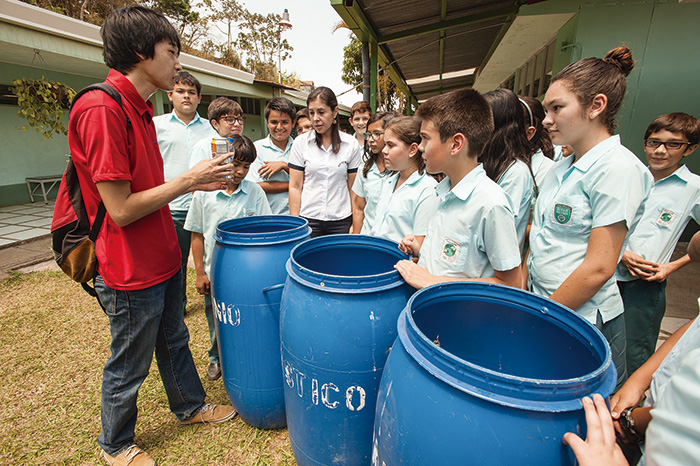
A Japan Overseas Cooperation Volunteer (environmental education), Mr. Kazuki Shioya conducts environmental education classes at a school in the city of Grecia, Costa Rica. Waste generated at the school shop is separated and the raw waste is composted. (Photo: Kenshiro Imamura, JICA)
- Note 24: The IPCC Fifth Assessment Report consists of the three assessment reports of Working Groups I, II, and III and the Synthesis Report, a report that integrates the findings of the three working group reports, published between 2013 and 2014.
- Note 25: Mitigation and adaptation measures refer to measures for reducing (mitigating) the emission of GHG that cause global warming, and measures for addressing (adapting to) the adverse impacts of climate change that are already occurring or could occur.
Thailand
Bangkok Master Plan on Climate Change 2013 – 2023
Technical Cooperation (March 2013 – September 2015)
Bangkok, the capital of Thailand, has a population of over 10 million. However, as the city’s economy continues to grow, its greenhouse gas emissions do so as well.
The Bangkok Metropolitan Administration (BMA) drew up the Bangkok Global Warming Mitigation Action Plan (Bangkok Action Plan) in 2007. The Action Plan features five major initiatives; namely 1) Expand Mass System; 2) Promote Energy Saving and the Use of Renewable Energy; 3) Improve Building Electricity Consumption Efficiency; 4) Improve Solid Waste Management and Wastewater Treatment Efficiency; and 5) Expand Green Areas. While the BMA has been working on the realization of these initiatives, Japan has been sharing its knowledge and experience with Bangkok to help the city realize these initiatives and implement the Bangkok Action Plan.
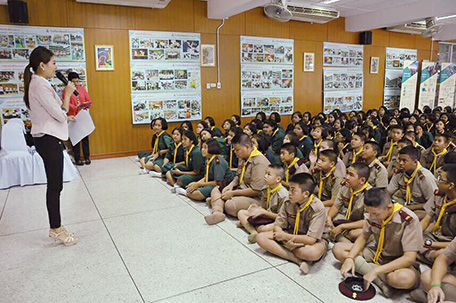
Public awareness event on traffic held at an elementary school. (Photo: JICA)
The BMA subsequently formulated the Bangkok Master Plan on Climate Change 2013 – 2023. This plan presents a more comprehensive approach to climate change based on the results and assessments of the Bangkok Action Plan. The plan does not only seek to mitigate climate change through measures to reduce greenhouse gases, including energy saving, but it also tries to adapt to the impacts of climate change, such as flooding and other events.
Japan has been assisting the BMA to implement this new plan. Japan has focused on creating a plan that is consistent with Thailand’s national policy, building cooperative relationships between the BMA and other organizations, and assisting with capacity building for the BMA officials who will be implementing the master plan.
Experts from many fields were dispatched to Thailand, such as transportation, energy, solid waste and wastewater treatment, urban greening, and adaptation. BMA officials also joined training in Japan. In addition, this project included city-to-city cooperation. The City of Yokohama participated in the project and shared its expertise on low-carbon cities with the BMA.
Japan’s assistance is contributing to the development of Bangkok to become a more sustainable and environmentally-friendly city.
Brazil
Project for Biodiversity Conservation in Amazon Based on a New Concept of ‘Field Museum’
SATREPS (Science and Technology Research Partnership for Sustainable Development)
(July 2014 – Ongoing)
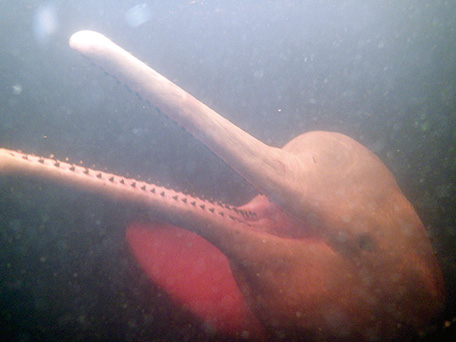
Sounds of the Amazon river dolphin, an endangered species, are recorded, and surveys are conducted on the species’ distribution and behavior patterns. The collected data is used in preservation activities. (Photo: JICA)
Manaus is the capital of the State of Amazonas in Brazil. It is located along the Amazon River’s largest tributary. The city has a diverse and precious natural environment with many national parks and conservation areas nearby. At the same time, the city has a population of around 2 million and a rapidly growing urban area, and this has led to environmental destruction.
As human activities continue to expand, they are destroying and degrading the tropical rainforest, and causing a significant loss of biodiversity. Addressing this loss of biodiversity to ensure the sustainable development of local communities is an urgent task.
Some progressive zoos and aquariums now serve as centers for environmental education, as well as ecosystem research and conservation. However, the Amazon region lacked such facilities in the past. In addition, it is difficult to continuously observe Amazonian organisms. Therefore, their habitats and ecosystems have remained largely unknown. Such a situation makes it difficult to formulate a suitable environmental policy for the region.
In light of this situation, Japan is providing assistance to the Amazon region in establishing a “field museum.” Instead of an ordinary museum housed in a building, the field museum is an outdoor museum within the actual natural environment, preserving wild animals there, unlike a regular zoo which keeps and exhibits animals in artificial facilities.
The National Institute of Amazon Research (INPA) is working together with Japan on the field museum, and in the museum it helps care for Amazonian manatees that have been injured by poachers. The institute is located downtown so it enables many citizens to learn about rare Amazonian wildlife.
As part of this project, experts dispatched from Japan are recording the sounds of the endangered Amazon river dolphin to study where it lives and how it behaves. This data is then utilized to aid conservation efforts. In addition, Japan also plans to fund the construction of a research station along the river on the outskirts of Manaus.
This research station will help researchers to investigate the Amazon’s rivers and rainforests. It could also be used to run eco tours and other efforts to deepen people’s understanding of the importance of the surrounding environment.
This project is also assisting efforts to research and conserve the habitats of aquatic wildlife. For example, it cares for and protects injured Amazonian manatees partially in the wild, before helping them return to nature. Another objective of the project is to shed light on ecosystems using the latest technologies and equipment. In this way, steady progress is being made to achieve harmony between humans and nature, based on the concept of a field museum. (As of August 2015)
